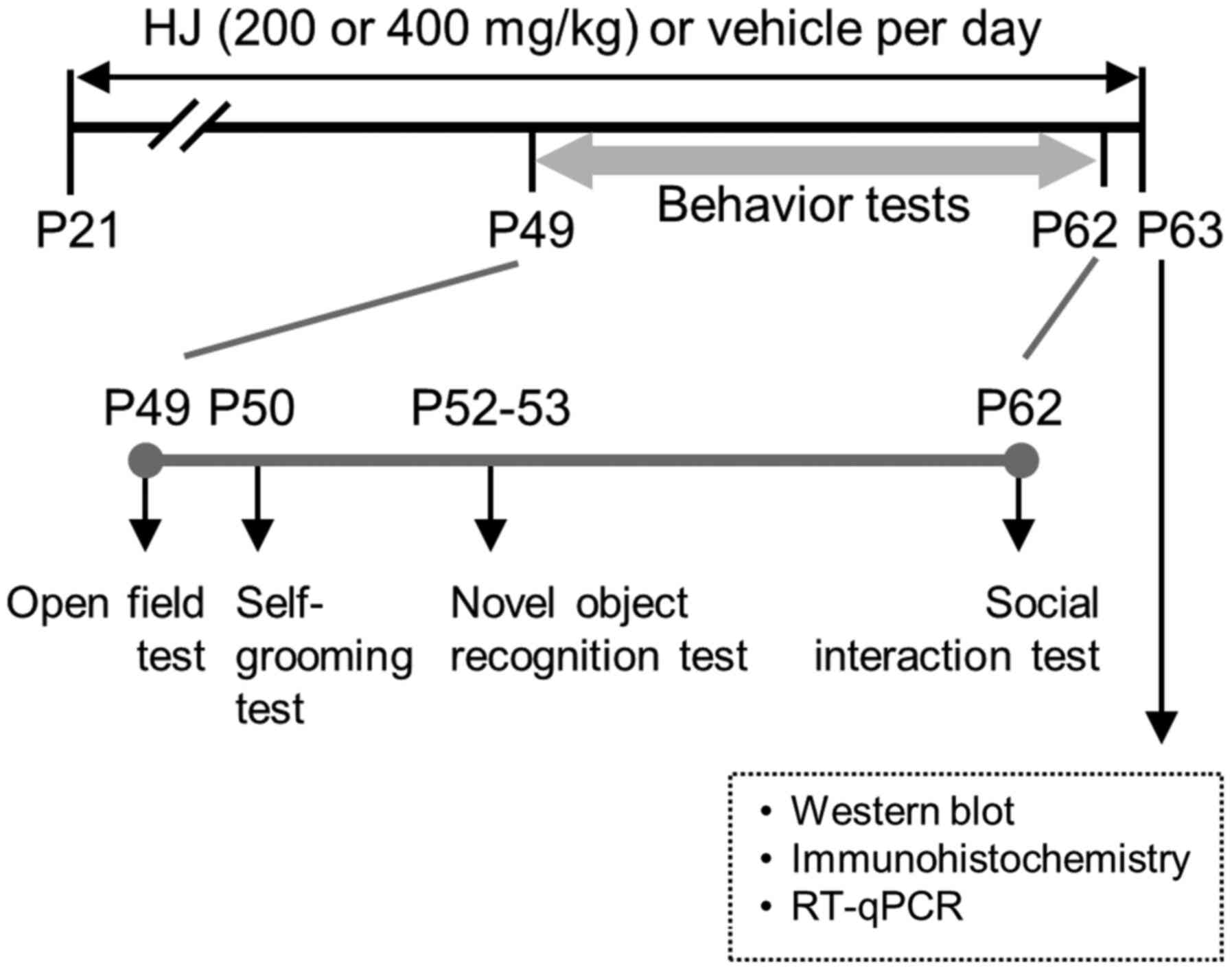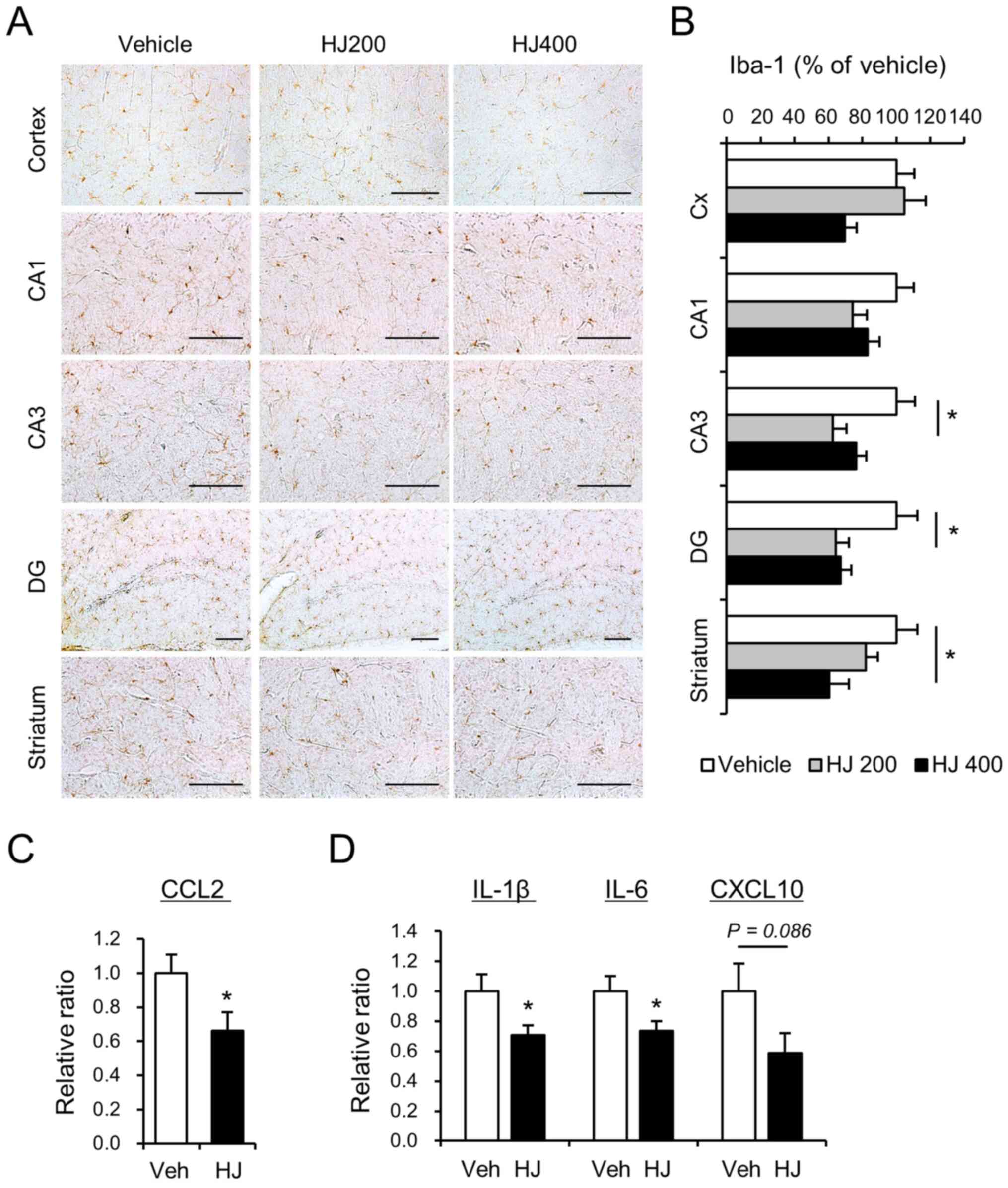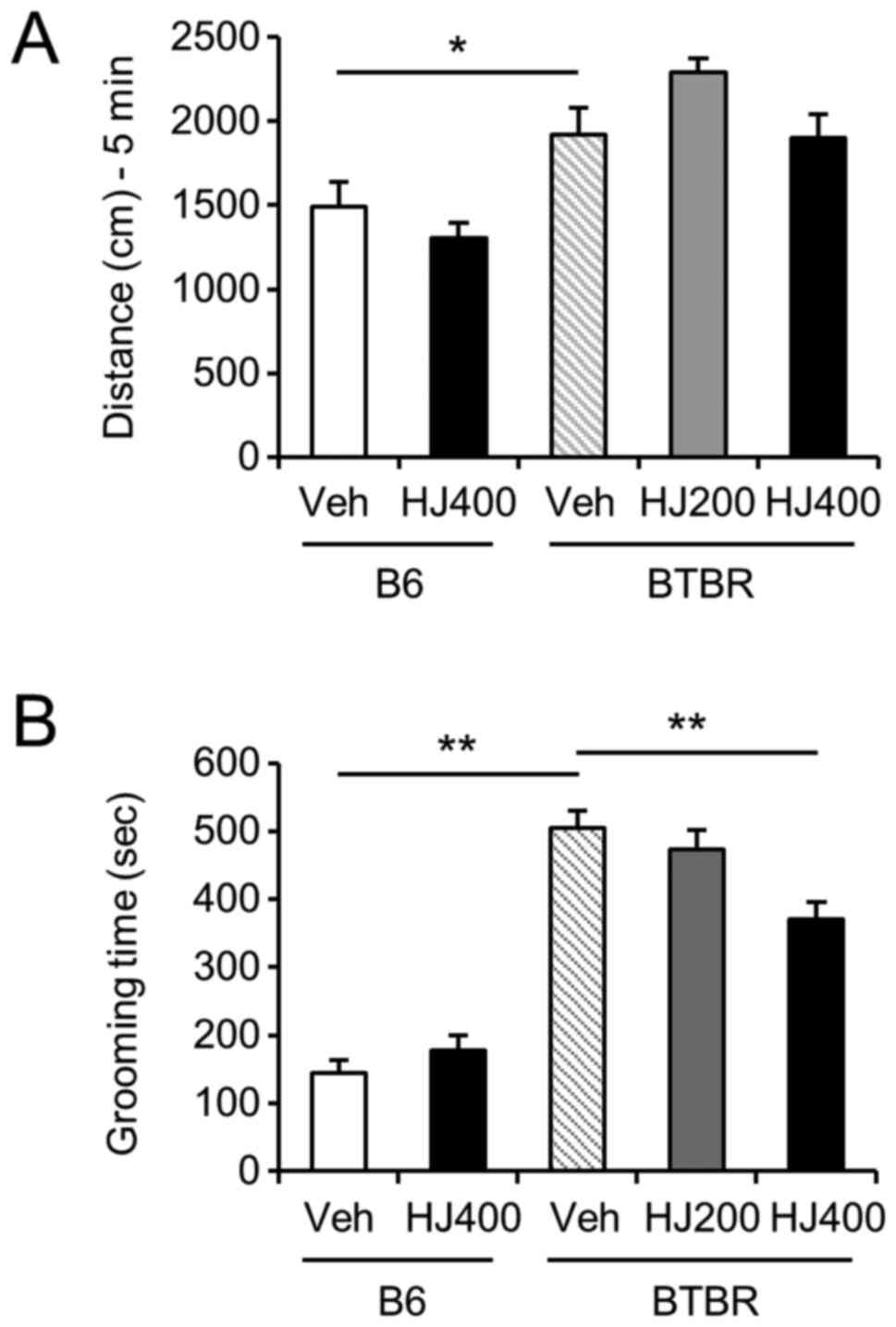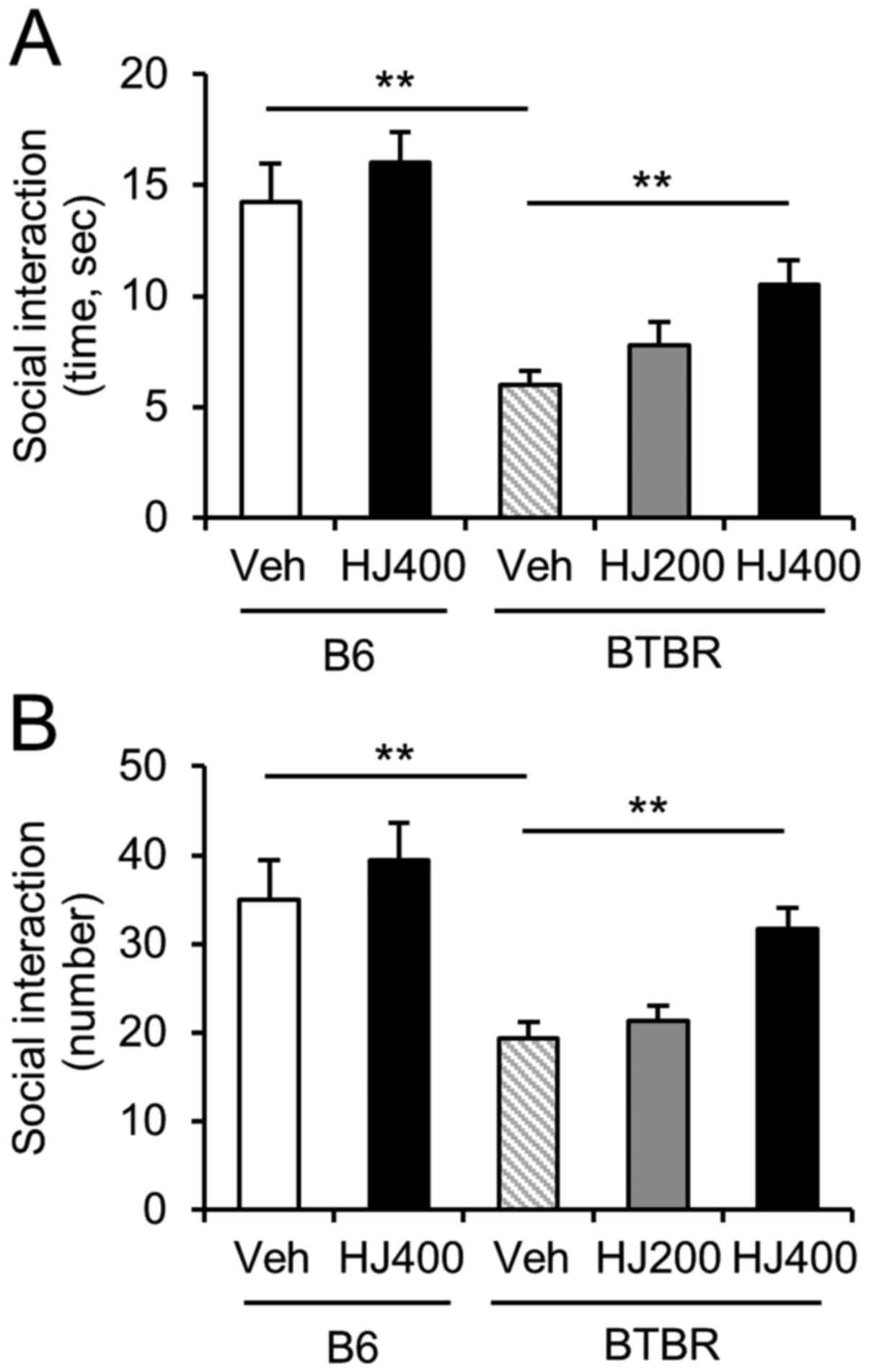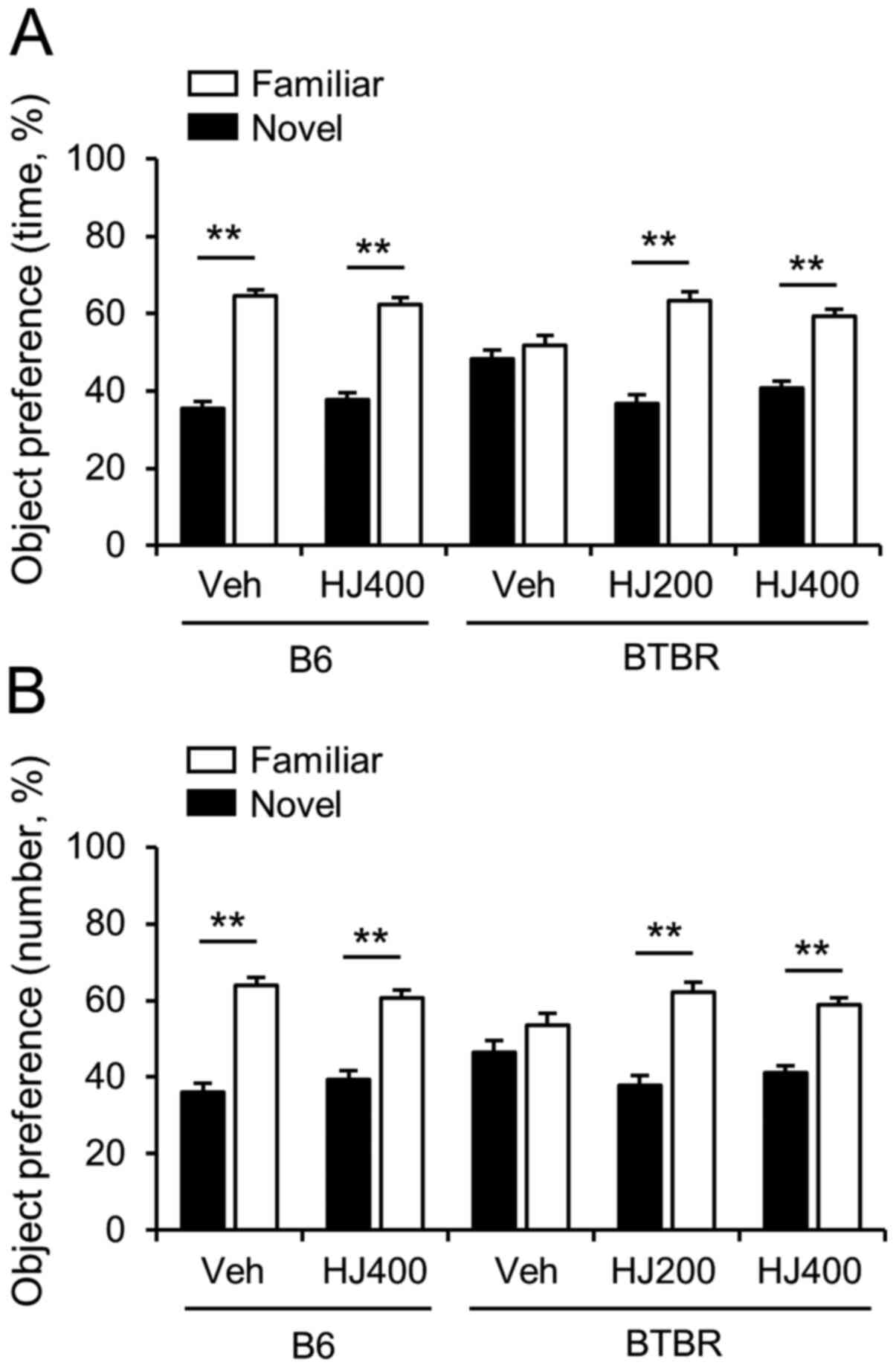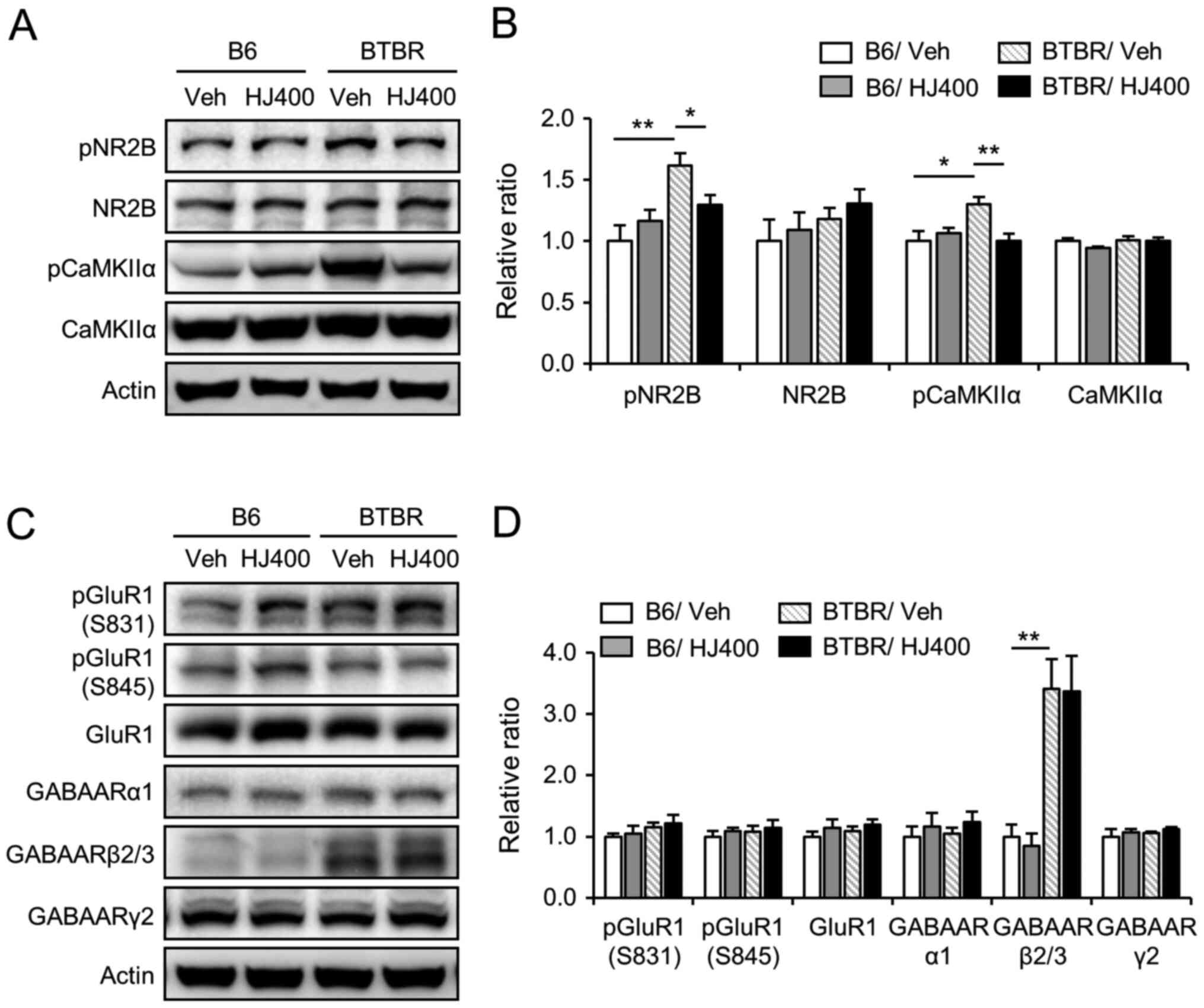|
1
|
Rommelse N, Langerak I, van der Meer J, de
Bruijn Y, Staal W, Oerlemans A and Buitelaar J: Intelligence may
moderate the cognitive profile of patients with ASD. PLoS One.
10:e01386982015. View Article : Google Scholar : PubMed/NCBI
|
|
2
|
McFarlane HG, Kusek GK, Yang M, Phoenix
JL, Bolivar VJ and Crawley JN: Autism-like behavioral phenotypes in
BTBR T+tf/J mice. Genes Brain Behav. 7:152–163. 2008. View Article : Google Scholar : PubMed/NCBI
|
|
3
|
Silverman JL, Tolu SS, Barkan CL and
Crawley JN: Repetitive self-grooming behavior in the BTBR mouse
model of autism is blocked by the mGluR5 antagonist MPEP.
Neuropsychopharmacology. 35:976–989. 2010. View Article : Google Scholar : PubMed/NCBI
|
|
4
|
Chao OY, Yunger R and Yang YM: Behavioral
assessments of BTBR T+Itpr3tf/J mice by tests of object attention
and elevated open platform: Implications for an animal model of
psychiatric comorbidity in autism. Behav Brain Res. 347:140–147.
2018. View Article : Google Scholar : PubMed/NCBI
|
|
5
|
Hardan AY, Minshew NJ and Keshavan MS:
Corpus callosum size in autism. Neurology. 55:1033–1036. 2000.
View Article : Google Scholar : PubMed/NCBI
|
|
6
|
Frazier TW and Hardan AY: A meta-analysis
of the corpus callosum in autism. Biol Psychiatry. 66:935–941.
2009. View Article : Google Scholar : PubMed/NCBI
|
|
7
|
Stephenson DT, O'Neill SM, Narayan S,
Tiwari A, Arnold E, Samaroo HD, Du F, Ring RH, Campbell B, Pletcher
M, et al: Histopathologic characterization of the BTBR mouse model
of autistic-like behavior reveals selective changes in
neurodevelopmental proteins and adult hippocampal neurogenesis. Mol
Autism. 2:72011. View Article : Google Scholar : PubMed/NCBI
|
|
8
|
Solek CM, Farooqi N, Verly M, Lim TK and
Ruthazer ES: Maternal immune activation in neurodevelopmental
disorders. Dev Dyn. 247:588–619. 2018. View Article : Google Scholar : PubMed/NCBI
|
|
9
|
Petrelli F, Pucci L and Bezzi P:
Astrocytes and microglia and their potential link with autism
spectrum disorders. Front Cell Neurosci. 10:212016. View Article : Google Scholar : PubMed/NCBI
|
|
10
|
Vargas DL, Nascimbene C, Krishnan C,
Zimmerman AW and Pardo CA: Neuroglial activation and
neuroinflammation in the brain of patients with autism. Ann Neurol.
57:67–81. 2005. View Article : Google Scholar : PubMed/NCBI
|
|
11
|
Kim JW, Hong JY and Bae SM: Microglia and
autism spectrum disorder: Overview of current evidence and novel
immunomodulatory treatment options. Clin Psychopharmacol Neurosci.
16:246–252. 2018. View Article : Google Scholar : PubMed/NCBI
|
|
12
|
Henstridge CM, Tzioras M and Paolicelli
RC: Glial contribution to excitatory and inhibitory synapse loss in
neurodegeneration. Front Cell Neurosci. 13:632019. View Article : Google Scholar : PubMed/NCBI
|
|
13
|
Park TS, Ryu YK, Park HY, Kim JY, Go J,
Noh JR, Kim YH, Hwang JH, Choi DH, Oh WK, et al: Humulus
japonicus inhibits the progression of Alzheimer's disease in a
APP/PS1 transgenic mouse model. Int J Mol Med. 39:21–30. 2017.
View Article : Google Scholar : PubMed/NCBI
|
|
14
|
Ryu YK, Kang Y, Go J, Park HY, Noh JR, Kim
YH, Hwang JH, Choi DH, Han SS, Oh WK, et al: Humulus
japonicus prevents dopaminergic neuron death in
6-hydroxydopamine-induced models of Parkinson's disease. J Med
Food. 20:116–123. 2017. View Article : Google Scholar : PubMed/NCBI
|
|
15
|
Hwang SY, Jo MJ, Kim SC and Jee SY:
Anti-inflammaory effects of the MeOH extract of Humulus
japonicus in vivo. J Korean Orient Med Ophthalmol Otolaryngol
Dermato. 22:92–103. 2009.
|
|
16
|
Go J, Park TS, Han GH, Park HY, Ryu YK,
Kim YH, Hwang JH, Choi DH, Noh JR, Hwang DY, et al: Piperlongumine
decreases cognitive impairment and improves hippocampal function in
aged mice. Int J Mol Med. 42:1875–1884. 2018.PubMed/NCBI
|
|
17
|
Edfawy M, Guedes JR, Pereira MI, Laranjo
M, Carvalho MJ, Gao X, Ferreira PA, Caldeira G, Franco LO, Wang D,
et al: Abnormal mGluR-mediated synaptic plasticity and autism-like
behaviours in Gprasp2 mutant mice. Nat Commun. 10:14312019.
View Article : Google Scholar : PubMed/NCBI
|
|
18
|
Yu X, Taylor AMW, Nagai J, Golshani P,
Evans CJ, Coppola G and Khakh BS: Reducing astrocyte calcium
signaling in vivo alters striatal microcircuits and causes
repetitive behavior. Neuron. 99:1170–1187 e1179. 2018. View Article : Google Scholar : PubMed/NCBI
|
|
19
|
Felix-Ortiz AC and Tye KM: Amygdala inputs
to the ventral hippocampus bidirectionally modulate social
behavior. J Neurosci. 34:586–595. 2014. View Article : Google Scholar : PubMed/NCBI
|
|
20
|
Kozera B and Rapacz M: Reference genes in
real-time PCR. J Appl Genet. 54:391–406. 2013. View Article : Google Scholar : PubMed/NCBI
|
|
21
|
Livak KJ and Schmittgen TD: Analysis of
relative gene expression data using real-time quantitative PCR and
the 2(-Delta Delta C(T)) method. Methods. 25:402–408. 2001.
View Article : Google Scholar : PubMed/NCBI
|
|
22
|
Ryu YK, Park HY, Go J, Choi DH, Kim YH,
Hwang JH, Noh JR, Lee TG, Lee CH and Kim KS: Metformin inhibits the
development of L-DOPA-induced dyskinesia in a murine model of
Parkinson's disease. Mol Neurobiol. 55:5715–5726. 2018. View Article : Google Scholar : PubMed/NCBI
|
|
23
|
Han YM, Cheung WK, Wong CK, Sze SL, Cheng
TWS, Yeung MK and Chan AS: Distinct cytokine and chemokine profiles
in autism spectrum disorders. Front Immunol. 8:112017. View Article : Google Scholar : PubMed/NCBI
|
|
24
|
Chen J, Tan L, Liao Y, Long J and Zhou Y,
Wei J and Zhou Y: Chemokine CCL2 impairs spatial memory and
cognition in rats via influencing inflammation, glutamate
metabolism and apoptosis-associated genes expression-A potential
mechanism for HIV-associated neurocognitive disorder. Life Sci.
255:1178282020. View Article : Google Scholar : PubMed/NCBI
|
|
25
|
Silverman JL, Pride MC, Hayes JE, Puhger
KR, Butler-Struben HM, Baker S and Crawley JN: GABAB receptor
agonist R-baclofen reverses social deficits and reduces repetitive
behavior in two mouse models of autism. Neuropsychopharmacology.
40:2228–2239. 2015. View Article : Google Scholar : PubMed/NCBI
|
|
26
|
Thames AD, Briones MS, Magpantay LI,
Martinez-Maza O, Singer EJ, Hinkin CH, Morgello S, Gelman BB, Moore
DJ, Heizerling K and Levine AJ: The role of chemokine C-C motif
ligand 2 genotype and cerebrospinal fluid chemokine C-C motif
ligand 2 in neurocognition among HIV-infected patients. AIDS.
29:1483–1491. 2015. View Article : Google Scholar : PubMed/NCBI
|
|
27
|
Zhou Y, Tang H and Xiong H: Chemokine CCL2
enhances NMDA receptor-mediated excitatory postsynaptic current in
rat hippocampal slices-a potential mechanism for HIV-1-associated
neuropathy? J Neuroimmune Pharmacol. 11:306–315. 2016. View Article : Google Scholar : PubMed/NCBI
|
|
28
|
Wang R and Reddy PH: Role of glutamate and
NMDA receptors in Alzheimer's disease. J Alzheimers Dis.
57:1041–1048. 2017. View Article : Google Scholar : PubMed/NCBI
|
|
29
|
Hermens DF, Chitty KM, Lee RS, Tickell A,
Haber PS, Naismith SL, Hickie IB and Lagopoulos J: Hippocampal
glutamate is increased and associated with risky drinking in young
adults with major depression. J Affect Disord. 186:95–98. 2015.
View Article : Google Scholar : PubMed/NCBI
|
|
30
|
Al-Otaish H, Al-Ayadhi L, Bjorklund G,
Chirumbolo S, Urbina MA and El-Ansary A: Relationship between
absolute and relative ratios of glutamate, glutamine and GABA and
severity of autism spectrum disorder. Metab Brain Dis. 33:843–854.
2018. View Article : Google Scholar : PubMed/NCBI
|
|
31
|
Groc L and Choquet D: Linking glutamate
receptor movements and synapse function. Science. 368:eaay46312020.
View Article : Google Scholar : PubMed/NCBI
|
|
32
|
Huo TG, Li WK, Zhang YH, Yuan J, Gao LY,
Yuan Y, Yang HL, Jiang H and Sun GF: Excitotoxicity induced by
realgar in the rat hippocampus: The involvement of learning memory
injury, dysfunction of glutamate metabolism and NMDA receptors. Mol
Neurobiol. 51:980–994. 2015. View Article : Google Scholar : PubMed/NCBI
|
|
33
|
Zhou Y, Tang H, Liu J, Dong J and Xiong H:
Chemokine CCL2 modulation of neuronal excitability and synaptic
transmission in rat hippocampal slices. J Neurochem. 116:406–414.
2011. View Article : Google Scholar : PubMed/NCBI
|
|
34
|
Han S, Tai C, Jones CJ, Scheuer T and
Catterall WA: Enhancement of inhibitory neurotransmission by GABAA
receptors having α2,3-subunits ameliorates behavioral deficits in a
mouse model of autism. Neuron. 81:1282–1289. 2014. View Article : Google Scholar : PubMed/NCBI
|
|
35
|
Lee HJ, Dhodary B, Lee JY, An JP, Ryu YK,
Kim KS, Lee CH and Oh WK: Dereplication of components coupled with
HPLC-qTOF-MS in the active fraction of Humulus japonicus and
it's protective effects against parkinson's disease mouse model.
Molecules. 24:14352019. View Article : Google Scholar : PubMed/NCBI
|















